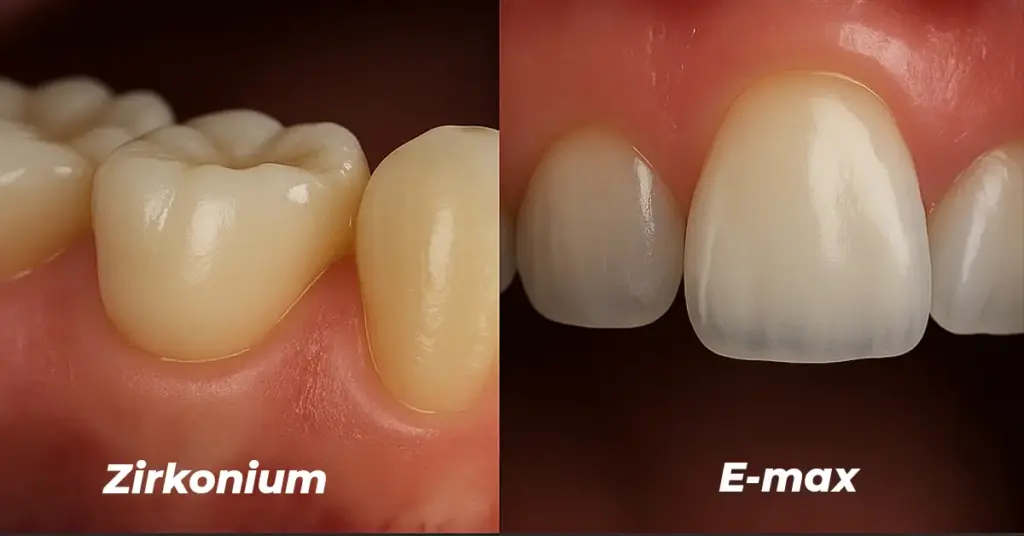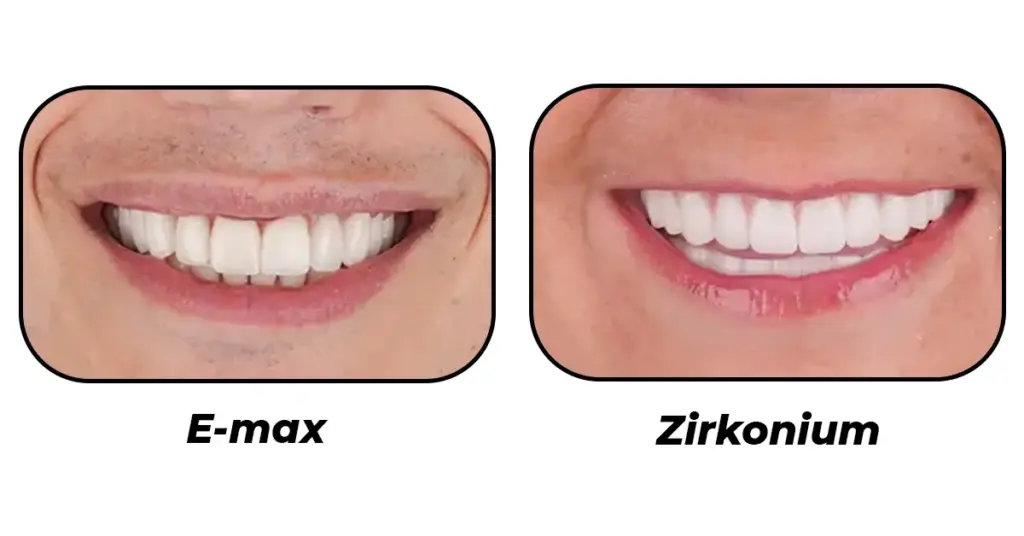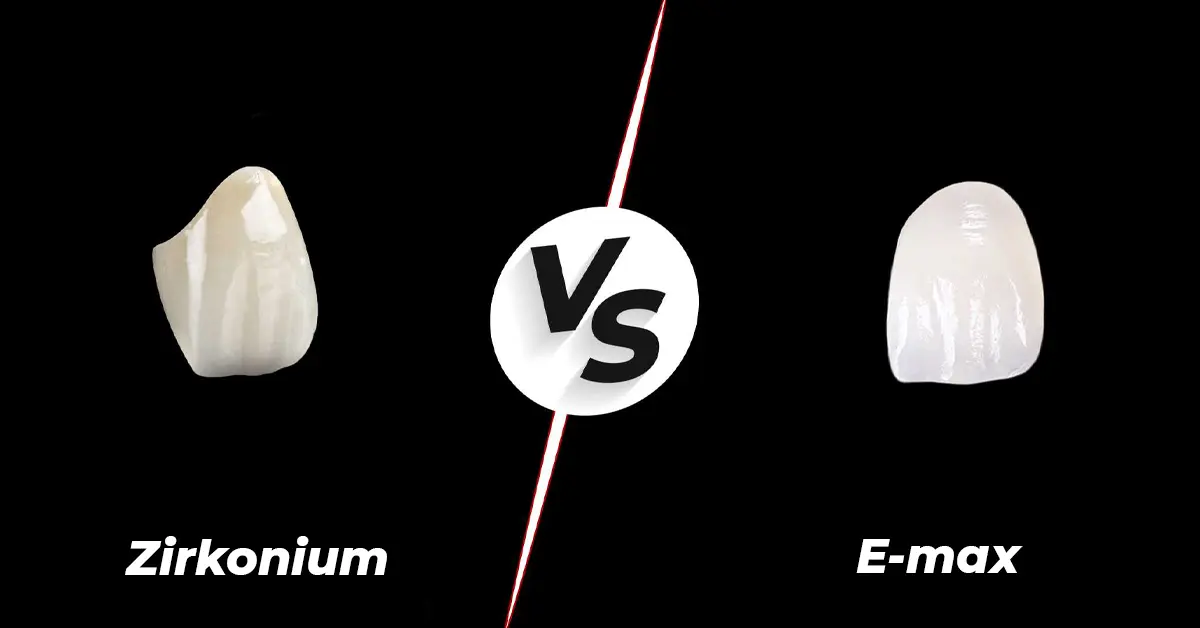Table of Contents
ToggleYour smile is a whole. Teeth, light, and lip line work together. The fundamental question here is clear: Zirconium or Emax? The answer depends on the tooth’s position, the shade of the underlying color, and your bite force. Aesthetic priorities also influence the decision. Should a dark underlying structure be concealed? Or is a “glass-like” transparency desired?
Both materials are biocompatible. The difference becomes apparent in their optical and durability properties. Below you will find a practical, clinically-based guide to help you make your choice. The sentences are short. The paragraphs are explanatory. Take notes as you go. Make the final decision based on your dentist’s plan and a trial fitting.
Zirconium or Emax? – Material and Aesthetics
Zirconium or Emax? Emax is a glass ceramic. It contains lithium disilicate. It has high light transmittance. It provides vibrant depth in anterior teeth. Zirconium is a strong substructure covered with ceramic. It is opaque. It masks the underlying color. It also hides the metal post. Emax remains conservative in cases requiring thin cuts. Zirconium provides relief in dark enamel and post-canal gray tones. Aesthetics depend on the laboratory’s craftsmanship. Color layering alters the result. Its polish reduces plaque retention. When you ask “Zirconium or Emax?”, the choice hinges on masking needs, translucency goals, and bite force.

Quick notes:
- “Glass effect” and brightness → Emax.
- “Masking” and covering the background → Zirconium.
- Fine preparation and minimal abrasion → Emax.
- Metal abutment or dark substructure → Zirconium.
Durability, Function, and Long Life
Biting force is high. The load increases, especially in bruxism. Zirconium responds well to this pressure. Fracture resistance is high. It is generally the first choice for multi-unit bridges. Emax provides sufficient strength for single teeth. Edge adaptation is strong. It is reliable in the anterior region. The longevity of both materials increases with care. Occlusion adjustment is critical. Night guards reduce the risk of cracks. Regular check-ups are essential. If the surface polish is maintained, the color remains stable.

Points to consider:
- History of bruxism → points in favor of zirconium.
- Single tooth aesthetics → Emax is a safe option.
- Bridge and implant crowns → zirconium is more tolerant.
Zirconium or Emax: Aesthetic Goal
The anterior region is visible. Light play is important. Reflections are noticeable on thin lip lines. Emax provides naturalness here. Color transitions are soft. If the underlying color is dark, the picture changes. Zirconia covers the base with its opacity. Edge transitions are better concealed in the gingival area. The posterior region is different. Chewing load increases. Zirconia carries this load. Emax can be selected for posterior single crowns. However, the indications are narrower. Photo and mock-up evaluation clarifies the decision.

Practical matching:
- Anterior single tooth and light depth → Emax.
- Dark substructure, metal post, implant → Zirconium.
- Posterior load and bridge requirement → Zirconium.
Clinical Process, Bonding, and Maintenance
The process begins with digital scanning. The form is tested with a temporary restoration. Emax is generally bonded with an adhesive protocol. Marginal leakage decreases. Resin-based cements are preferred for zirconium. Retention is increased. Occlusion testing is important. Contacts are polished. Surface luster is preserved. Maintenance then comes into play. Use a soft brush. Add an interdental brush and dental floss. Do not bite hard foods with a crushing motion. A night guard prevents cracks. Schedule a checkup every six months.

Care list:
- Brush twice daily.
- Do not neglect interdental cleaning.
- Do not brush immediately after acidic drinks.
- Use a night guard (if you have bruxism).
- Polishing and checkup every six months.
Decision Matrix and Sample Scenarios
Simplify the decision based on the goal. Natural light and transparency? Or masking and strength? Single tooth? Bridge? Are you a bruxer? See the final image with photos and a temporary restoration. If you are satisfied, proceed. If you are unsure, request an alternative trial. If the budget is close, technical suitability becomes the deciding factor. Laboratory quality changes the result. Experience makes a difference.
Quick decision chart:
- “Most natural front teeth” → Emax.
- “Strength + covering dark backgrounds” → Zirconium.
- “Multi-unit bridge / implant-supported” → Zirconium.
- “Minimal abrasion” → Emax.
- “Bruxism” → Zirconium is preferable.
Check out our social media accounts to see the excellent results.
Zirconium or Emax? – FAQ
Zirconium or Emax, which is more aesthetic?
Emax is generally preferred in the front region for light depth and naturalness. Zirconium is more successful when it is necessary to mask a dark base.
Which is preferred for dark root canal-treated teeth, zirconium or Emax?
Zirconium for its masking power. It better covers the gray/metal background.
Which is more natural for a single front tooth: zirconium or Emax?
Emax. It provides a “glass effect” with high translucency and layering.
If there is bruxism (teeth grinding), should zirconium or Emax be chosen?
Zirconium. It is more tolerant with its high fracture resistance. A night guard is recommended.
For a single crown in the posterior region, zirconium or Emax?
Either can be used; high chewing load makes zirconium advantageous. If the indication is narrow, Emax can also be chosen.
For a bridge plan, which material, zirconium or Emax?
Zirconium is mostly preferred for multi-unit bridges.
Which hides better for implant abutments and metal posts: zirconia or Emax?
Zirconia. Its opaque structure covers the substructure.
If I want minimal preparation and to preserve tooth structure, should I choose zirconia or Emax?
Emax. Conservative work is done with minimal abrasion.
Which is more durable: zirconia or Emax?
Zirconium is more durable for bridges and high loads. Emax provides sufficient durability for single teeth.
Are the bonding protocols for zirconium and Emax different?
Emax is mostly bonded with adhesive (resin cement), which reduces marginal leakage. In zirconium, resin-based cements increase retention.
Which is better for color stability and surface polish, zirconium or Emax?
Both give good results. Regular polishing and maintaining the polish preserves color stability.
Which one hides transitions better at the gum line (gingival margin), zirconia or Emax?
Zirconia is advantageous if the underlying color is dark. Emax offers a natural transition on a neutral base.
Why are temporary crowns and try-ins important in zirconia and Emax treatments?
They test form, function, and aesthetics beforehand. The decision is clarified with photos and mock-ups.
What should I pay attention to in zirconium and Emax care?
Brush twice a day, clean between teeth, wait after acidic drinks before brushing, use a night guard if you have bruxism, check-up/polishing every 6 months.
In which cases is Emax clearly preferred?
Single anterior tooth, high aesthetic expectations, cases requiring minimal abrasion.
In which cases is zirconium the clear choice?
Dark substructure/metal post, implant-supported, bruxism, posterior load, and bridge requirements.

